Choosing what to wear kayaking is not as easy as you might think. Making the wrong choice has a huge impact on your overall experience, leaving you roasting in the sun or shivering from the cold. For this reason, I’ve had a look at the ideal kayaking wear for various situations.
What you wear kayaking is determined by the water temperature. You should layer your clothes accordingly. In any situation, your clothes should be moisture wicking materials such as neoprene. A wetsuit is recommended in water temperatures between 45-60oF, and a drysuit for colder conditions.
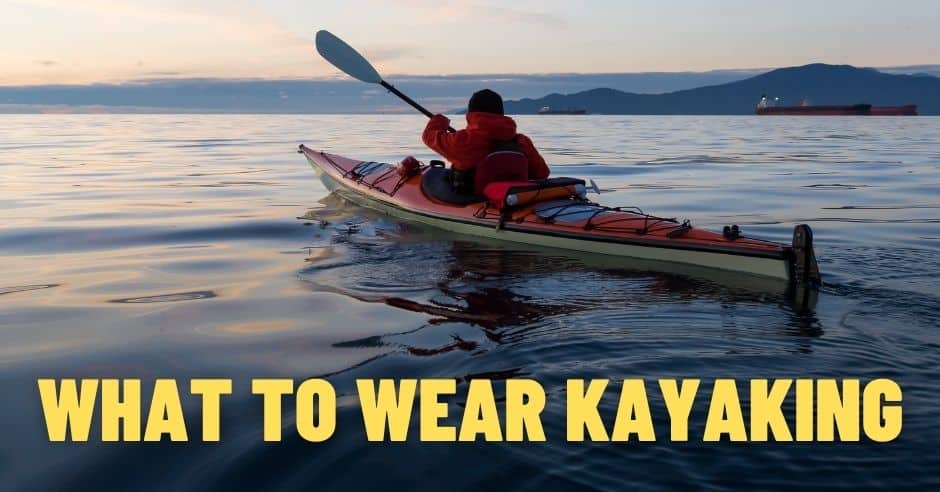
Preparing for both the weather and the water temperature can be challenging. Below is a more in-depth explanation of what you should wear when kayaking. There are also other factors that can affect this decision, which I have included below.
Dress for the Water Temperature Not the Air
Water temperature is the most important thing to consider when dressing for your kayaking journey. You have to assume you are going to fall out of the kayak, because even the most experienced kayakers still do sometimes. With this in mind, you can dress appropriately to keep you safe.
When planning your trip, you can go online to check the water temperature of a specific river or coast. There are also a few other factors that will determine which clothing is appropriate, including
- Weather
- Air temperature
- Kayaking pace (fast-paced paddling will warm you up quickly)
- Type of kayak (sit-on-top or sit-inside)
As a general rule, you should avoid all cotton clothing. This is because cotton absorbs water and sweat, but also draws the heat away from your body.
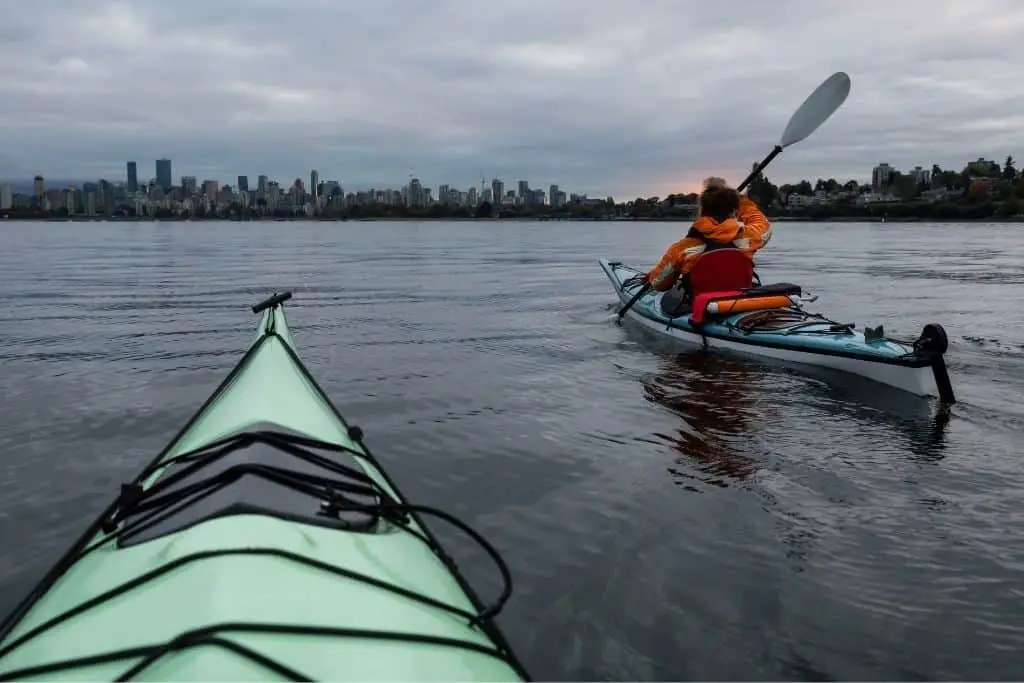
Ideal materials for kayaking are synthetic materials with moisture wicking properties. These will draw the sweat away from your body, keeping you dry. Sweat will be uncomfortable in summer and make you cold in winter.
Here’s a list of the best moisture wicking materials for kayaking:
- Neoprene
- Nylon
- Polyester
- Polyurethane
- Fleece
- Merino Wool (although this is heavy when wet and takes a long time to dry)
These materials are recommended for both cold and warmer temperatures. The key is to use layers. For warmer climates, a single thin layer will provide ventilation but protect you from the sun. In cooler temperatures, several layers will keep you warm, but will dry quickly and draw cold moisture away from your body.
In any temperature, you should wear comfortable shoes with a rubber sole, such as river shoes or neoprene boots. These types of shoes will protect the soles of your feet and prevent you from slipping on wet rock when getting in and out of the kayak.
Another thing you should always have is a personal flotation device, or lifejacket. This will keep you afloat if you fall into the water.
Kayak Design: Sit-On-Top vs. Sit-Inside
Kayaks are designed to either sit on top or inside the kayak. As I mentioned earlier, your choice of the two will help determine your outfit.
Sit-On-Top Kayak
Sit-on-top kayaks provide maximum ventilation and will not protect your lower half from getting wet, which is ideal for warmer weather. They are also quicker and easier to climb back onto if you fall off, which in colder climates will reduce your risk of hypothermia.
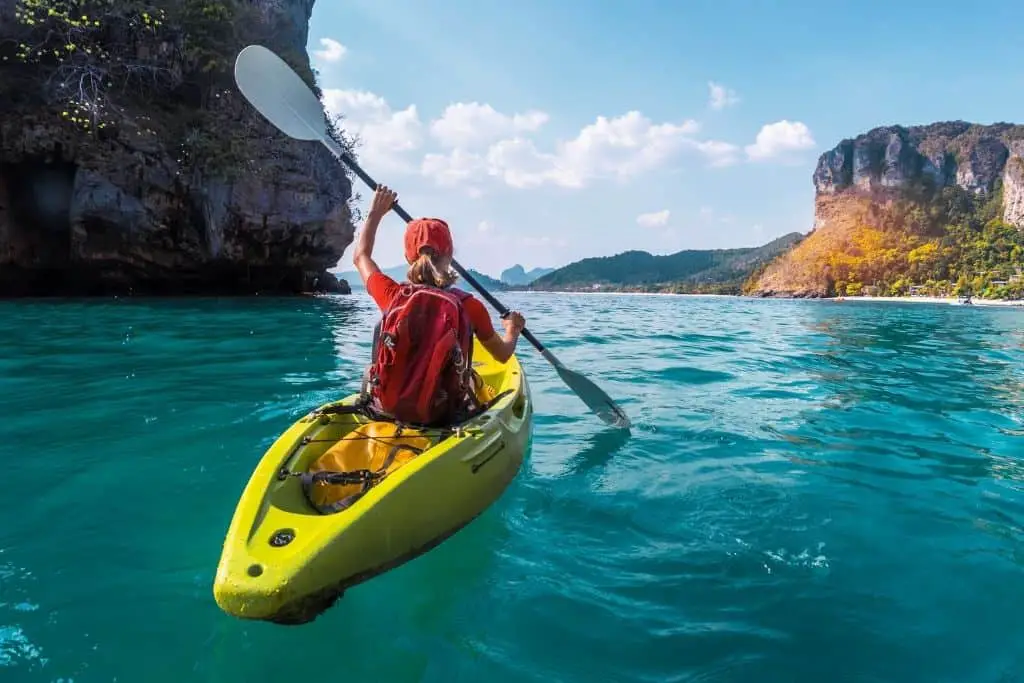
Sit-Inside Kayak
The sit-inside design is harder to get back into but will keep your lower half warm in cold conditions. You can also attach a skirt to the opening to help keep your lower half dry.
Overall, if you have a sit-on-top kayak, you might need more layers to keep you warm. If you have a sit-inside kayak, you should be dressed for longer submersion in the water.
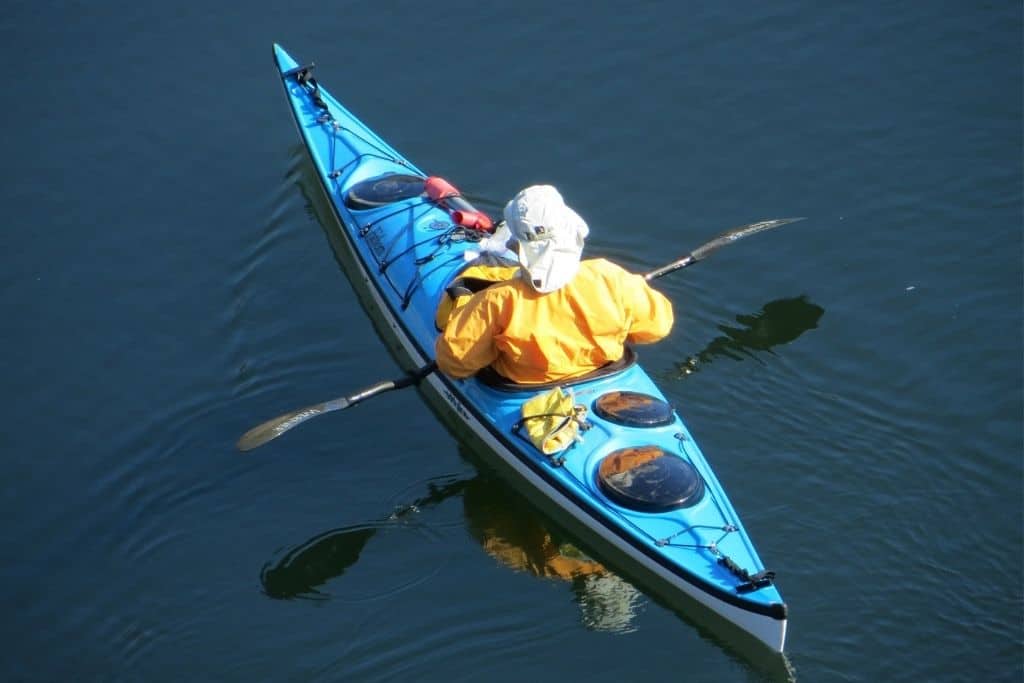
What to Wear Kayaking in Summer (Hot Air – Warm Water)
In summer, or in hotter climates with warm water temperatures, you have more chance of overheating from the sun than being too cold in the water. Therefore, if you’re in a situation where the water temperature is more than 60oF, you should dress for the weather, not the water.
The sun not only bears down from above, but will also reflect off the water. This means you can get very hot very quickly and be burnt from multiple directions.
Ideally, you should wear long sleeves and pants that are thin and light. These will protect you from the sun and will actually keep you cool if you select the following materials: Neoprene, Nylon, Polyester, Polyurethane.
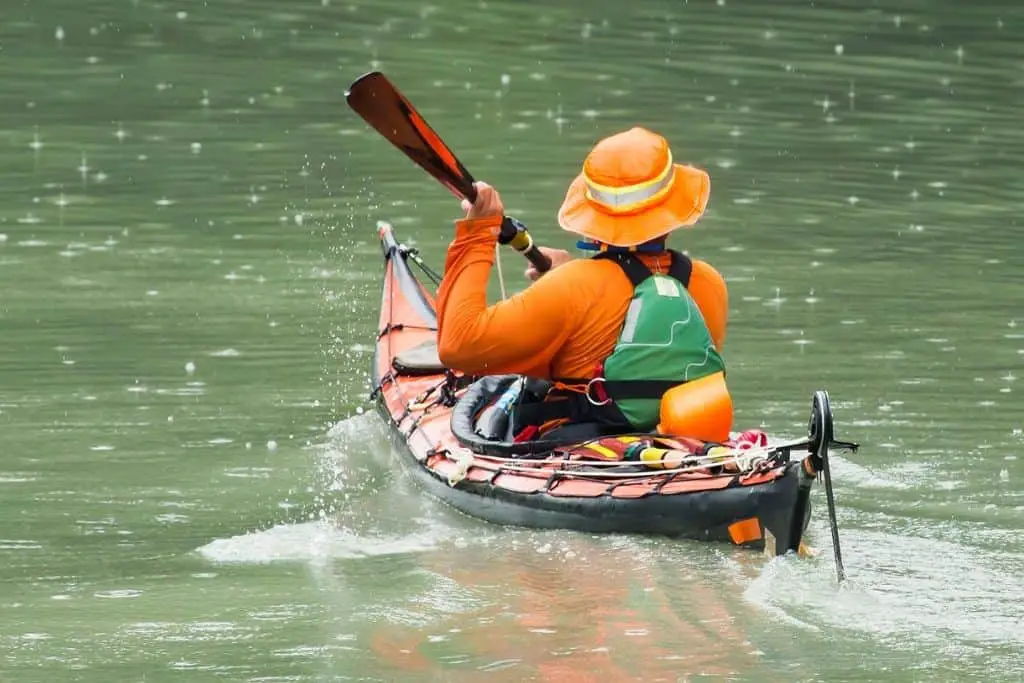
If you don’t like the idea of long sleeves and pants, something like a rashguard and board shorts is another great option. You’ll just need to make sure you apply sunscreen and maybe consider bringing a waterproof jacket in case the wind becomes cold.
For your head, you will need a wide-brimmed hat with a chin-strap so it doesn’t blow off in the breeze. Polarised sunglasses are also recommended to protect your eyes from the intense sun-glare, but there’s a chance they could fall in the water. You can prevent this with a strap or attach floats so they don’t sink.
See also: Canoe vs Kayak
You should even consider your underwear. You could wear a swimsuit instead or any non-cotton underwear and sports-bra under your clothes.
You might be tempted to wear thongs or other summer shoes, but neoprene boots or river shoes are still ideal to protect your feet and provide grip on slippery surfaces.
Summary: What to Wear Kayaking in Summer
- Non-cotton underwear or swimsuit
- Top (long sleeve or short sleeve)
- Bottoms (pants or shorts)
- Wide-brimmed hat
- Polarised sunglasses
- Neoprene boots or river shoes
- Lifejacket
What to Wear Kayaking in Warm Weather (Warm Air – Cold Water)
Kayaking in warm weather over cold water is one of the hardest situations to dress for. This is common when kayaking over large, deep lakes. In this situation, you should always dress for the water temperature.
As a general rule, if the combined air and water temperatures are below 120oF, you should wear a wetsuit. This can be long-sleeved or short-sleeved but will provide you with extra insulation if you fall into the water. You can opt for nothing underneath, but some people prefer wearing a swimsuit underneath for comfort from chafing.
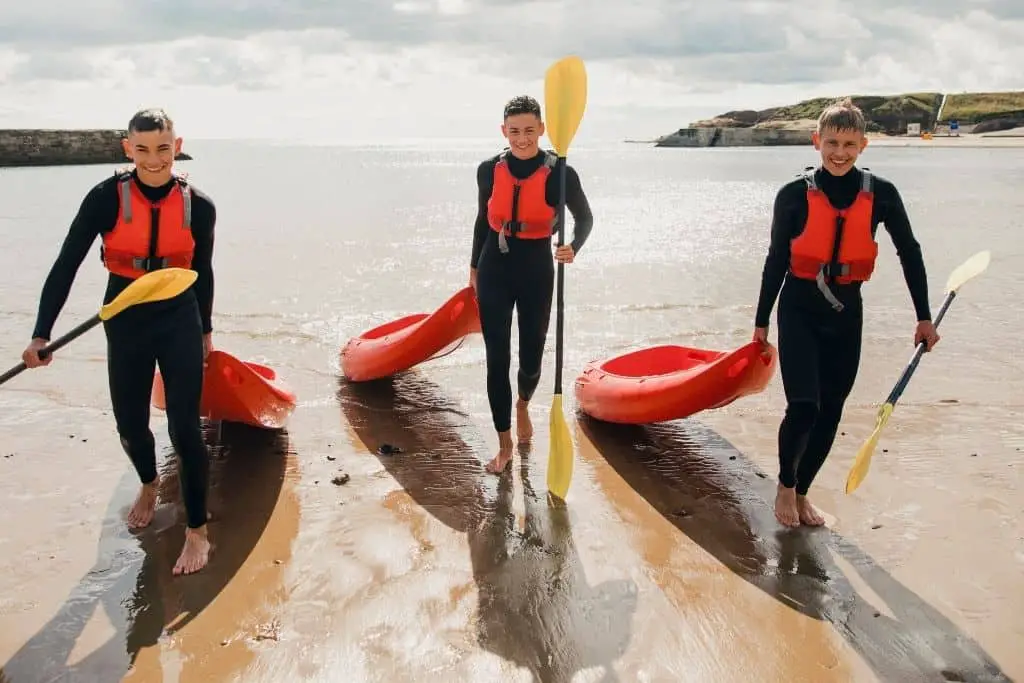
On top of your wetsuit you should dress in layers according to the temperature. Any of the synthetic materials mentioned above will be quick to dry and are a good option.
You should still wear a hat, sunglasses and appropriate shoes, as well as bring a waterproof jacket. But you might also consider some waterproof socks and neoprene gloves to help keep your hands and feet warm in the water.
Summary: What to Wear Kayaking in Warm Weather
- Wetsuit (with or without a swimsuit)
- A light top and pants (if wearing anything over the wetsuit)
- Wide-brimmed hat
- Polarised sunglasses
- Neoprene boots or river shoes with waterproof socks (unless your wetsuit covers your feet)
- Neoprene gloves
- Lifejacket
What to Wear Kayaking in Cold Weather (Cold Air – Cold Water)
As the water temperature falls below 45oF, there is a high risk of hypothermia if you fall in the water. This is incredibly dangerous as your body will no longer be able to function normally, which could lead to drowning. Wetsuits are not really effective in these temperatures, therefore drysuits are recommended instead.
The drysuit is waterproof, but will not keep you warm so should be worn over multiple layers of clothing. They are designed so that sweat will evaporate and keep you dry, which is good for long or intense kayaking trips.
Your layers under the drysuit should consist of long thermal underwear, a long-sleeve top and pants and something like a fleece jacket. This will keep your core body temperature warm.
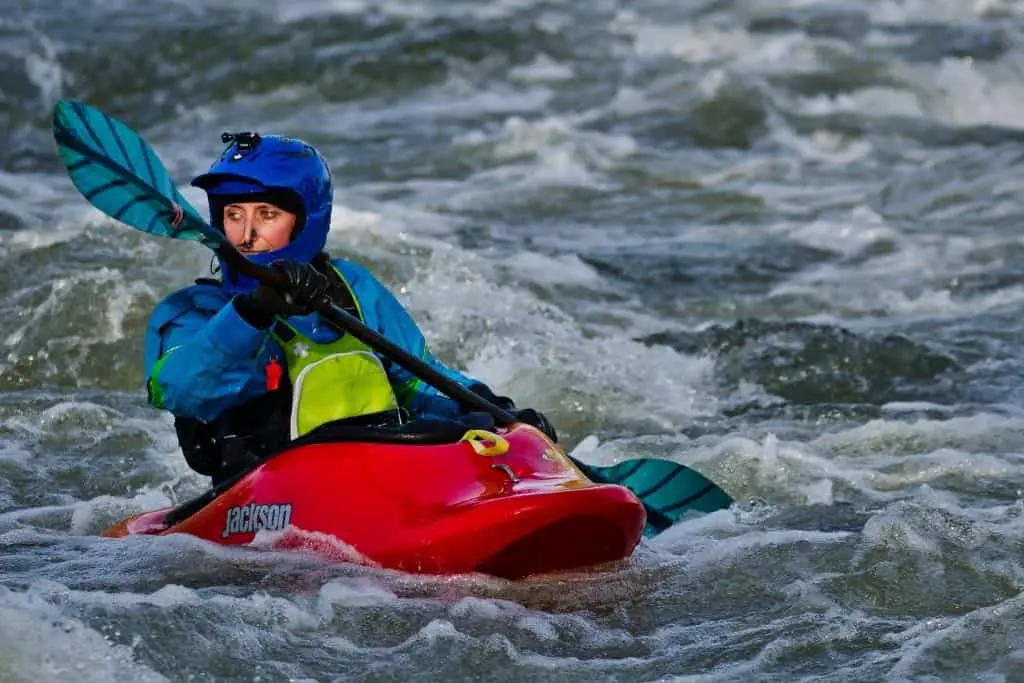
You should also have a thermal hat, buff or facemask for your head, neoprene boots and waterproof socks for your feet and neoprene gloves for your hands. You may also consider Pogies, which attach to your paddles and provide your hands with extra warmth and protection.
On top of that, it’s recommended to bring extra clothes in a waterproof bag so that you have warm dry clothes to change into afterwards.
Summary: What to Wear Kayaking in Cold Weather
- Long thermal underwear
- Long-sleeved top and pants
- Fleece jacket
- Thermal hat, buff or facemask
- Neoprene boots with waterproof socks
- Neoprene gloves
- Pogies
- Lifejacket
- Extra clothes in a waterproof bag
Final Thoughts
I hope this has helped clarify any questions you had about what to wear for your next kayaking trip. You should be able to enjoy kayaking without worrying about being too hot or too cold. All the best on your next trip!
